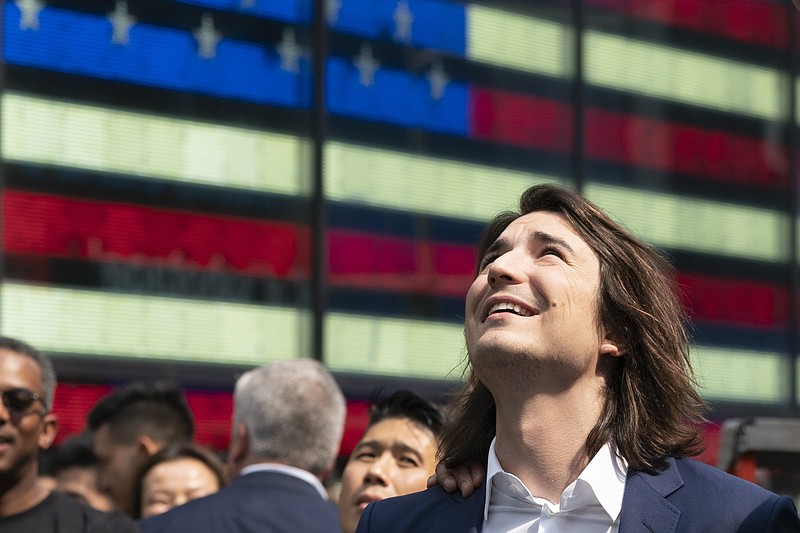Robinhood was met with an icy welcome from Wall Street on Thursday as the company's stock sank by as much as 10% during its first day of trading.
After opening at $38 per share -- the low end of its projected price range, which pegged its valuation at around $32 billion -- the company's stock wobbled in the afternoon session, closing the day at $34.82, or down 8%.
The Menlo Park, Calif.-based company said it netted nearly $2 billion from the sale of roughly 55 million shares. About a third of its shares were offered directly to its own users -- who numbered more than 22 million at the end of the second quarter -- in a rare move for a major initial public offering.
Overall, the stock market finished the day in positive territory, with the S&P 500-stock index, the Dow Jones industrial average and the tech-heavy Nasdaq up by a fraction of a percent.
[Video not showing up above? Click here to view » https://www.youtube.com/watch?v=-TIHM7BwEdg]
Robinhood has enjoyed staggering growth, more than quadrupling the number of monthly active users since 2019. Young and novice investors have flocked to the app, which pioneered a host of user-friendly features that legacy brokerages have since widely adopted, including no-fee trading, no account minimums and the ability to buy fractions of a share.
"Robinhood has in a way transformed how retail investors interact with the markets and invest in the markets, and in general I think that's a good thing, allowing broader access to retail investors," said Reena Aggarwal, professor of finance at Georgetown University and director of the Center for Financial Markets and Policy.
Regulators, however, are increasingly concerned about the potential hidden costs of zero-commission trading, she added. Investors may confront huge volatility as retail traders are often driven by sentiment and a "follow the crowd" approach, Aggarwal said.
From 2019 to 2020, Robinhood's revenue exploded 245% from $277.5 million to $958.8 million. The company's mission is to "democratize finance for all," according to its prospectus, which noted that more than half of its customers are first-time investors.
But such populist appeals also have attracted criticism that the company exploits the naivete of inexperienced investors, and that the seamlessness of the app and the revelry it inspires has "gamified" stock trading in ways that could harm users.
"The mounting regulatory risk Robinhood faces makes us concerned that the public may see Robinhood's stated goal to 'democratize investing' as a ruse to lure them into speculative trading and gambling that benefits Robinhood more than the individual investor," David Trainer, chief executive of New Constructs, wrote in commentary ahead of the offering. "That said, there are many beautiful casinos in Las Vegas that are tributes to the willingness of millions of people to lose money gambling."
Hugh Tallents, a senior partner at the management consultancy cg42, said Robinhood has a lot to be proud of after forcing the market for online investing to make products that are intuitive, more mobile and easier to understand. He described the valuation as overly ambitious, with a business model that will require a huge influx of new customers, even as the company operates from a position of mistrust for some users after the meme stock trading frenzy erupted in January.
"The risk is that they become the ultimate meme stock themselves," he said.
Robinhood makes most of its money from a practice known as payment for order flow, where the company charges large investment firms called "market makers" fees to access real-time information about which stocks its users are buying and selling.
The business model is seen by some regulators and industry watchers as a potential conflict of interest. Such payment for order flow practices have "drawn heightened scrutiny from the U.S. Congress, the SEC, state regulators, and other regulatory and legislative authorities," Robinhood said in its prospectus.
Ahead of the IPO, Robinhood disclosed that regulators are examining the trading activity of its employees leading up to the online broker's move to restrict trading on GameStop and other meme stocks earlier this year. It's also being asked about its two founders' compliance with financial registration rules.
The initial pricing for the stock and its early fall were discouraging signs for Sandra Marvel, a 49-year-old investor from Raymore, Missouri, who had been planning on buying shares.
"I completely abandoned my plan," she said. "It doesn't look good. I think there are a lot better trades out there."
Marvel, who left her job in insurance sales last year to trade stocks full time, has been using Robinhood since 2018.
Jeffrey Colindres-Soto, a 26-year-old from Miami, was a Robinhood user who did buy the stock, 20 shares for $33.85 apiece. But it may not be long before he sells it.
"If it gets to $38, I make my profit and that's it," he said.
If it goes the other way, the valet-parking supervisor plans to dump the stock before it goes below $35.50.
Information for this article was contributed by Taylor Telford and Hamza Shaban of The Washington Post and by Stan Choe and Alex Veiga of The Associated Press.

